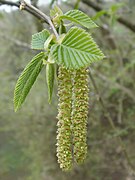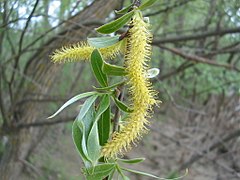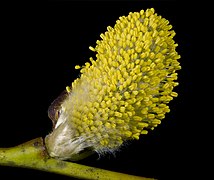Catkin
From Wikipedia, the free encyclopedia
A catkin or ament is a slim, cylindrical flower cluster, with inconspicuous or no petals, usually wind-pollinated (anemophilous) but sometimes insect pollinated (as in Salix). They contain many, usually unisexual flowers, arranged closely along a central stem which is often drooping. They are found in many plant families, including Betulaceae, Fagaceae, Moraceae, and Salicaceae. For some time, they were believed to be a key synapomorphy among the proposed Hamamelididae, but it is now believed that this flower arrangement has arisen independently by convergent evolution on a number of occasions.[citation needed]
In many of these plants only the male flowers form catkins, and the female flowers are single (hazel, oak), a cone (alder) or other types (mulberry). In other plants (such as poplar) both male and female flowers are borne in catkins.
Catkin-bearing plants include many other trees or shrubs such as birch, willow, hickory, sweet chestnut and sweetfern (Comptonia), and also some herbaceous plants such as nettle.
The word catkin is a loanword from the Dutch katteken, meaning "kitten", on account of the resemblance to a kitten's tail.[1] Ament is from the Latin amentum, meaning "thong" or "strap".[2]
|
A male catkin on a willow ( Salix sp.) |
|
Female flowering catkin on a willow ( Salix sp.) |
|
References
- ^ Catkin, Oxford English Dictionary, Second Edition, 1989. Accessed 30 November 2009. [1]
- ^ Ament, Oxford English Dictionary, Second Edition, 1989. Accessed 30 November 2009. [2]





